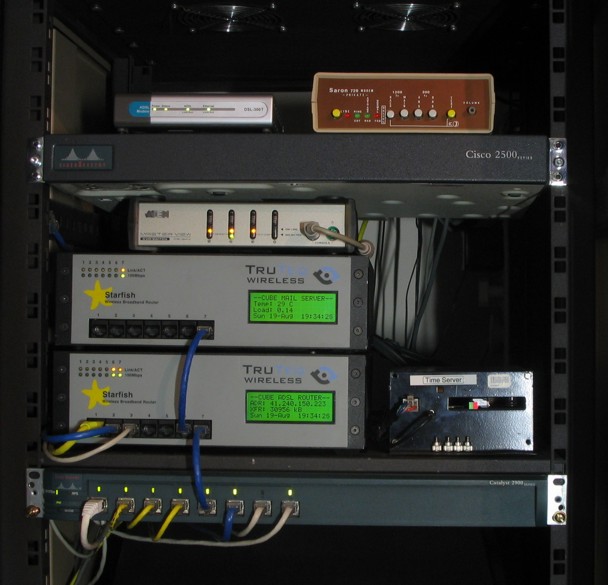Right at the top you can see an old Cisco 2509-series router that I managed to patch up from a variety of different broken routers. On top of the router is the DSL modem and a 1200 bps radio TNC.
Below the Cisco router is a four port KVM. Below that KVM are two Truteq devices that I hacked into a DSL router+firewall and a mail server. Both boxes run Slackware Linux (see below). They're called FW and MINI respectively.
Then follows an 8-port 100MBit Cisco Catalyst 2908 managed enterprise switch which forms the backbone of the Cube network. It connects the servers, access points and workstations together.
AKNOT, the top-most server, is a Windows 2000 Server box. It's an oldish 800MHz Pentium-III machine with 384MB RAM. The real worth of this machine is it's 120GB RAID array. It's where I store most of my valuable data. In order to be more "Green" this machine will be decomissioned soon.
ZORG, in the middle, is my main (and stable) development Unix box. Currently it runs Slackware Linux 12.0. This is a 2.0GHz Dual Core Pentium-IV with 4GB of RAM, two 250GB SATA2 disks in a RAID1 configuration (using 'md'). It also shares mounted storage with AKNOT.
ICE, right at the bottom, runs Slackware Linux 12.0. It's a Pentium-III with 512MB of RAM. It handles two WiFi connections. One destination is just under 1km away and the other is about 5.5km away. It basically just acts as a router and has enough PCI ports for more long-distance WiFi connections. It has 370GB of non-redundant storage.
On top of the Catalyst, to the right is a Trimble Ace II GPS receiver which supplies an accurate PPS pulse and time stream to ZORG, which also acts as my time server.
The entire system is housed in a 19" cabinet in my "lab". Each server sits on its own shelf for easy access and removal. The whole cabinet is powered by a 2KVA online UPS that sits downstairs in the garage.
A new addition to the home network is a Seagate BlackArmor NAS device, for large capacity central storage. A truely neat device for redundant (RAID1, RAID5 and RAID10), mass storage.



